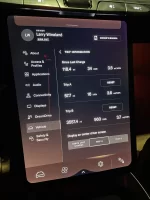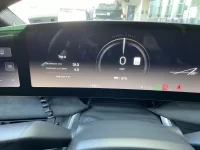Reviving an old thread as I found this one very helpful as a new owner. Sounds like we've got a lot of new owners recently so maybe we can get some more data.
1000 miles in. I'm average 3.4 mi/kw which is pretty good but not as good as I was expecting.
Mix of highway and city driving. I'm normally averaging 75 on the highway. Temps in the 60's-70's here for most of my ownership. I'm not an aggressive driver in terms of acceleration but do get up into 80 on the highway so I know that's a significant penalty.
Best I've done is 3.7 mi/kw when I'm paying attention and being very gentle on moderate highway driving. Worse is under 2 around the city with lots of rapid acceleration.
Coming from 6 years of EV driving, I'm pretty used to one pedal driving. Though to be fair, the reason I switched was b/c my Model X was pretty bad. 15% penalty for the 22inch wheels, another 15% penalty for SUV on the highway. My range was supposed to be 225 and I usually got closer to 160. Putting me well below 2 on the mi/kw. It was a P90D so math would be 1.8. I guess I should be very happy with my current 3.7 on the Lucid.
I eagerly await the completion of the break in period and will see if it really gets better. I would have expected to be in the 4 range pretty consistently with my driving style.
I'd encourage all the new owners to fill in the survey so we have more data. And for people that have had the car an additional two months to check back in and tell us if the break in period really is a thing.
1000 miles in. I'm average 3.4 mi/kw which is pretty good but not as good as I was expecting.
Mix of highway and city driving. I'm normally averaging 75 on the highway. Temps in the 60's-70's here for most of my ownership. I'm not an aggressive driver in terms of acceleration but do get up into 80 on the highway so I know that's a significant penalty.
Best I've done is 3.7 mi/kw when I'm paying attention and being very gentle on moderate highway driving. Worse is under 2 around the city with lots of rapid acceleration.
Coming from 6 years of EV driving, I'm pretty used to one pedal driving. Though to be fair, the reason I switched was b/c my Model X was pretty bad. 15% penalty for the 22inch wheels, another 15% penalty for SUV on the highway. My range was supposed to be 225 and I usually got closer to 160. Putting me well below 2 on the mi/kw. It was a P90D so math would be 1.8. I guess I should be very happy with my current 3.7 on the Lucid.
I eagerly await the completion of the break in period and will see if it really gets better. I would have expected to be in the 4 range pretty consistently with my driving style.
I'd encourage all the new owners to fill in the survey so we have more data. And for people that have had the car an additional two months to check back in and tell us if the break in period really is a thing.




